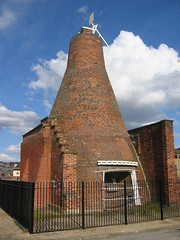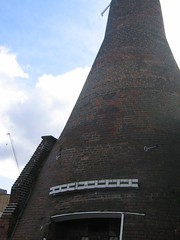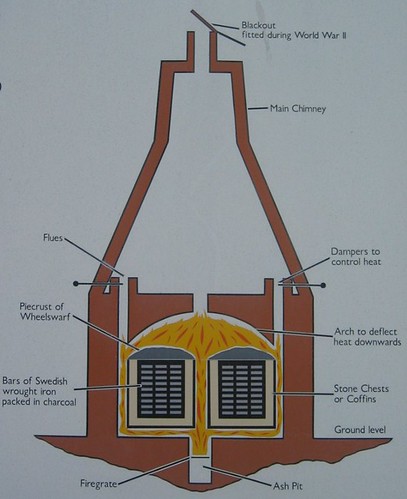 Travellers using Sheffield's Inner Ring Road might just catch a glimpse of part of the city's industrial heritage. Standing in HSBC's car park on Doncaster Street is the only complete cementation furnace left in Sheffield. The furnace is a large bottle shaped structure, outwardly similar to the bottle kilns used by pottery manufacturers. It is an unusual structure, very different to everything around it, but it is constructed from red brick, so it is surprisingly easy to pass by without even noticing it.
Travellers using Sheffield's Inner Ring Road might just catch a glimpse of part of the city's industrial heritage. Standing in HSBC's car park on Doncaster Street is the only complete cementation furnace left in Sheffield. The furnace is a large bottle shaped structure, outwardly similar to the bottle kilns used by pottery manufacturers. It is an unusual structure, very different to everything around it, but it is constructed from red brick, so it is surprisingly easy to pass by without even noticing it.The cementation process combined carbon with iron to create bars of blister steel - named for the characteristic blisters on its surface. The process involved heating wrought iron bars and charcoal. The raw materials were packed in layers into two large sandstone chambers, known as coffins, which were sealed off with a mixture of clay and waste from grinder's wheels before the furnace was fired. The entrances to the chambers (known as charging holes) were also sealed up with bricks and clay.
The furnace was coal fired and heated the iron until it was red hot, but not molten. Once heated to this state, the iron softened and reacted with the carbon in the charcoal to form steel. Firing was a lengthy process typically lasting for around 7-10 days, followed by several more days of cooling before anyone could enter the furnace to remove the newly formed blister steel. The furnace had a surprisingly large capacity - a plaque at the site reports it at 40 tons. Let me put that in perspective for you: as an engineering student (studying metallurgy and materials science), I did a work placement at a local company that still makes special steels for the aerospace industry; their furnace had a capacity of 10 tonnes, although the firing was a lot faster than at Doncaster Street.
Blister steel was an important product in the Sheffield steel industry that was used to make a variety of tools. Unfortunately it also contained impurities which adversely affected the quality of the steel. Huntsman's crucible process could remove many of the impurities in blister steel to create a much better quality product - but more about that another time.
 The Doncaster Street furnace was built in around 1848 and was one of five operated by Daniel Doncaster, a well known local steelmaking company. It was last fired in 1951.
The Doncaster Street furnace was built in around 1848 and was one of five operated by Daniel Doncaster, a well known local steelmaking company. It was last fired in 1951.One interesting feature of this particular furnace is the slightly odd structure on the top. This dates from World War II (although it has been restored somewhat). The top of the flue would be easily visible during firing, but given that the firing lasted for days and couldn't be stopped at short notice, a method of concealing the flue was needed. The solution was basically a metal flap that could swing down to cover the top of the flue in event of an air raid. The flap is attached to a frame and has a lever to assist in lowering it. I suspect that actually operating this when the furnace was being fired would be quite difficult.
The furnace is in very good condition, having been restored by Midland Bank (now HSBC) during the early nineties. It is fenced off (no bad thing), so it is not readily accessible, but it is easily visible. The sign states that a key is available on request from the curator of Kelham Island Museum - although the phone number is out of date and the museum is still recovering from flood damage, so we didn't try this. It didn't matter - we had a good view of the furnace from the street and from just inside the bank's car park. We visited on a Sunday, when few people were working there, I don't know if the same relaxed attitude to sightseers would apply in the week.
I'd love to actually get inside it, but somehow I suspect that wouldn't be allowed.
Links
This furnace is part of The Furnace Trail. A leaflet describing the trail is available from local bookshops, including the one at Abbeydale Industrial Hamlet. The leaflet gives a link to Upper Don Walk trust's site but there don't seem to be details of The Furnace Trail online just yet.
All my posts about the Kelham Furnace Trail
My Flickr photoset for this furnace
--
Originally published here on my main blog http://three-legged-cat.blogspot.com/
Comments on the original post

